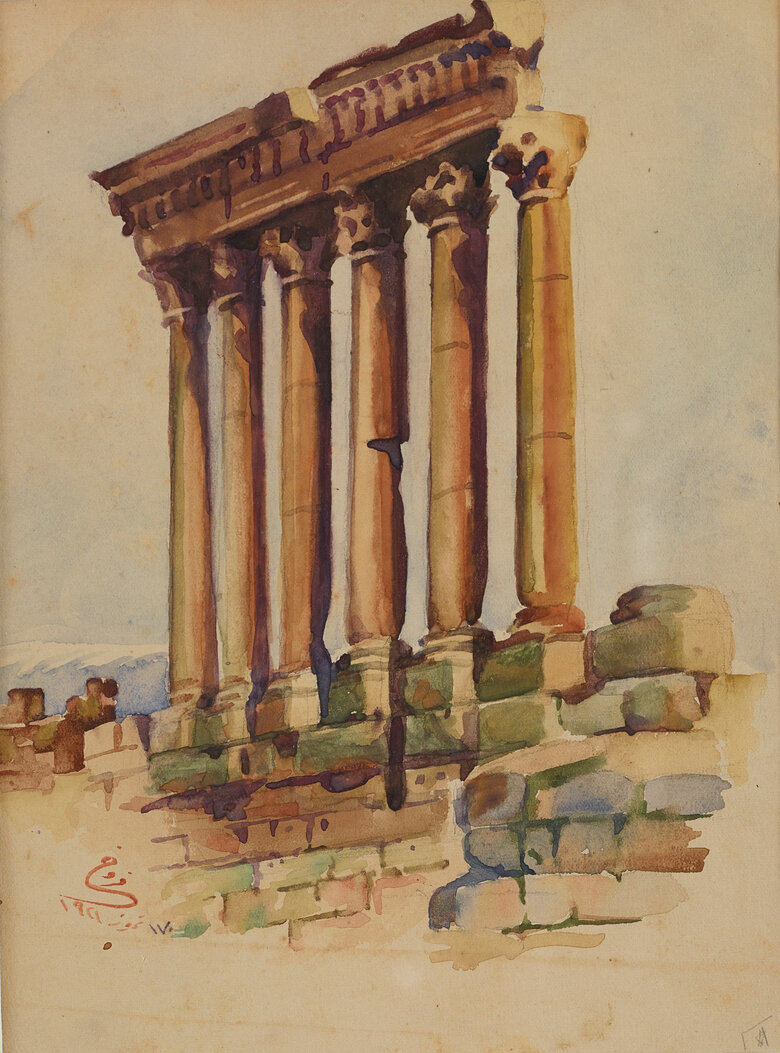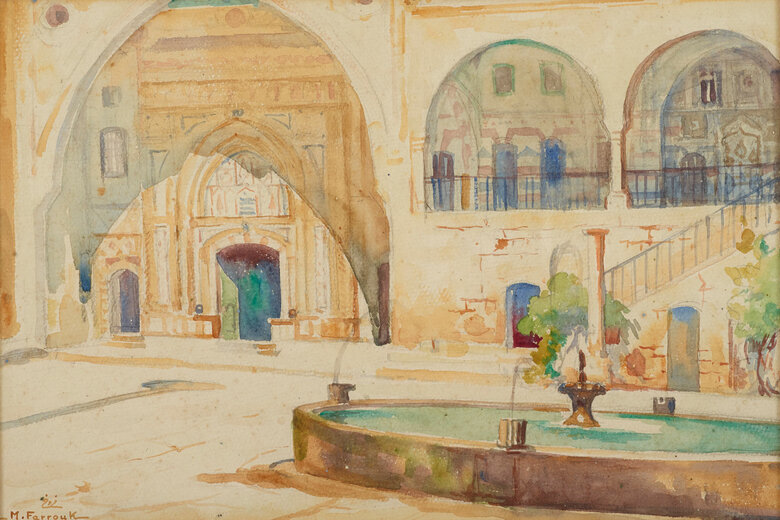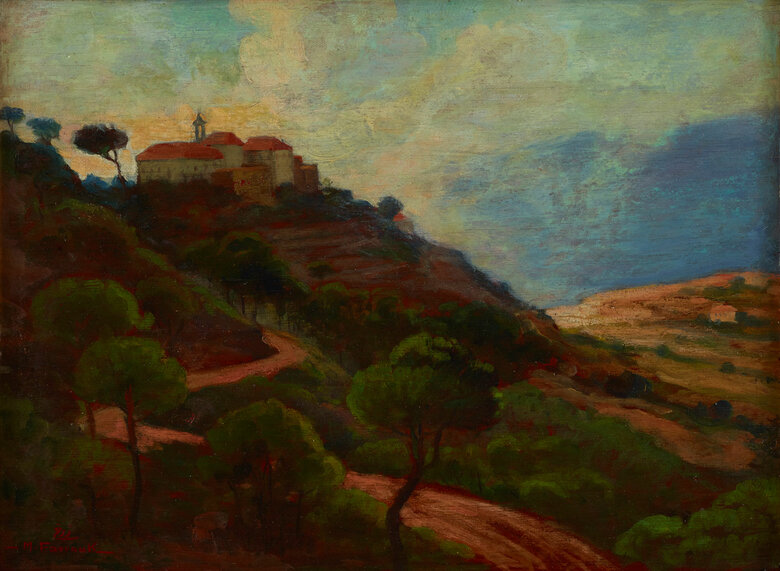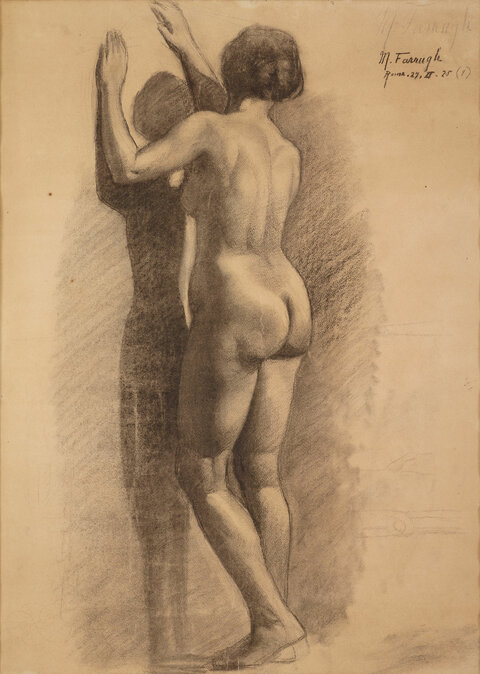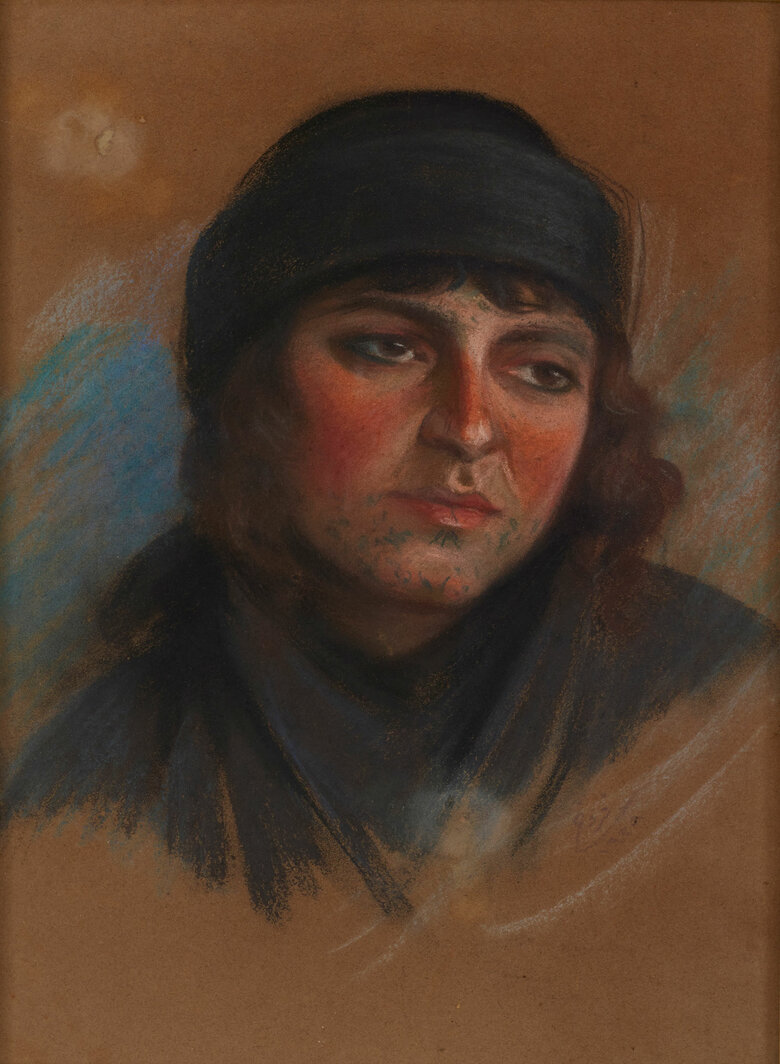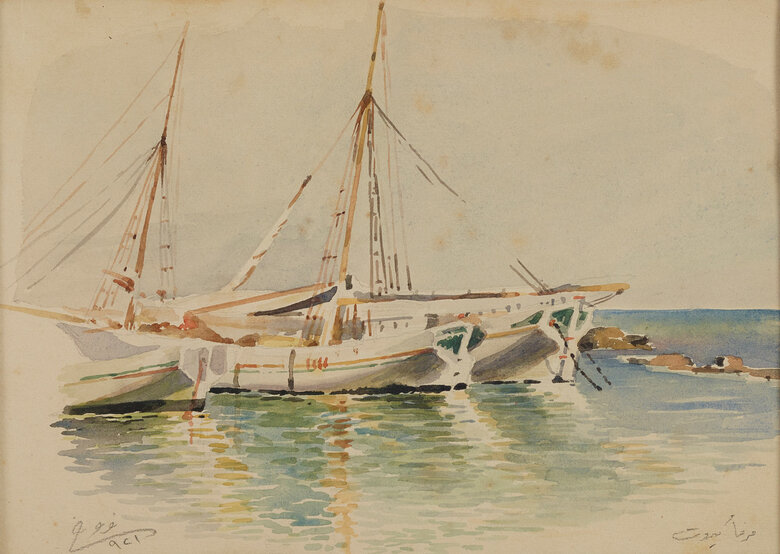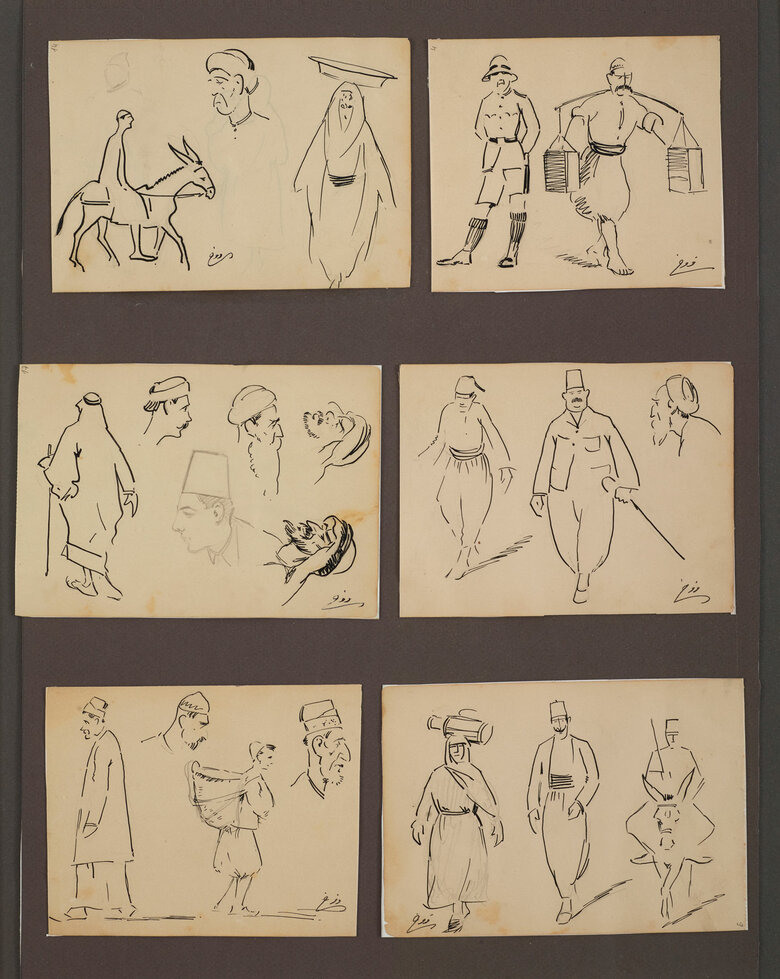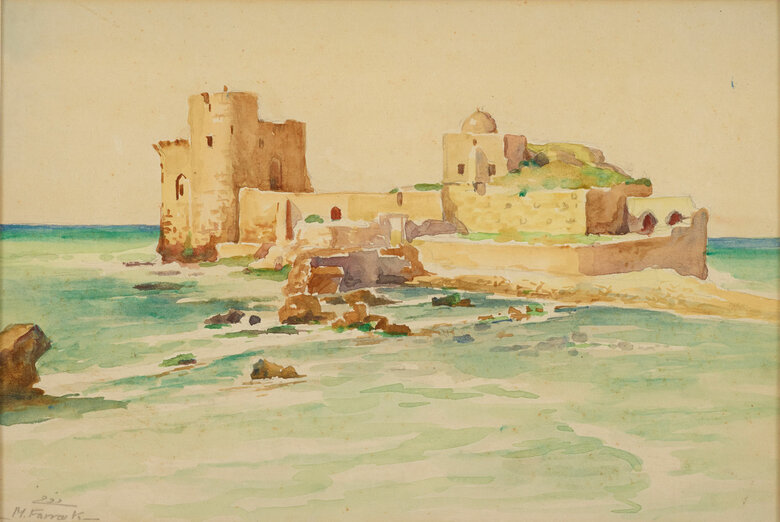Written by Liam Sibai Born in 1901, Moustafa Farroukh was brought up in a humble Beiruti household in Hai Al-Basta. He received encouragement and technical instruction from the Lebanese modernist...
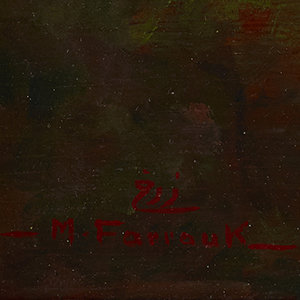

MOUSTAFA FARROUKH, Lebanon (1901 - 1957)
Bio
Written by Liam Sibai
Born in 1901, Moustafa Farroukh was brought up in a humble Beiruti household in Hai Al-Basta. He received encouragement and technical instruction from the Lebanese modernist Habib Serour in the artist's studio before pursuing a formal training at the Regia Accademia di Belle Arti denominati di San Luca. He graduated in 1927 and went to Paris to continue his studies and further immerse himself in the artistic trends of the era, which he did under Paul Emile Chabas and Jean Louis Forain. During his time in Europe, Farroukh displayed his works in the Parisian Salons and traveled to Spain to explore his interest in Andalusian architecture.
In 1929, an exhibition of Farroukh’s work launched at the American University of Beirut; it was the first solo exhibition Lebanon had ever seen.
Upon his return to Beirut in 1932, Farroukh established a permanent exhibition of his work in his studio, becoming a fixture in the Beiruti art scene as well as at AUB, where he lectured.
Farroukh's work is an exemplary product of its time. As the French mandate replaced Ottoman rule in Lebanon, public patronage replaced personal commission. More support went to art concerned with the intellectual, personal, or aesthetic than with the demonstration of power, “civility,” or legitimacy, as had been popular under the Ottomans. Painters began to explore more pastoral, humanistic subject matter, and to play with light and medium specificity. Much like his contemporaries Cesar Gemayel and Omar Onsi, Faroukh brought self-aware modernism to Lebanese imagery. Farroukh's rhetoric and spirit influenced several artists that came after him, including Saloua Raouda Choucair, whom Farroukh trained personally.
Farroukh's subjects can be found laboring, nude, or in contemplation. Most importantly, they always express human tenor, even when nonhuman or inanimate. The use of blunt hastened brushstrokes, and gestural figuration endows his paintings with organic warmth and emphasizes the hand of the artist, imbuing the painting and its subjects with a glow of humanity. Though of an urban background, Farroukh often found himself painting Lebanon's lakes and vineyards, enthralled by the natural beauty of his country. He also painted the built environment, including vistas of villages, Beiruti architecture, and individual structures in different areas such as Deir Al-Qamar, Ain Saide, or Abadiyé. Even his beloved Andalusian design was rendered in Cordoba, The Grand Mosque (1930).
Farroukh helped bring the nude tradition to Lebanon, believing, as many of his contemporaries did, that the subversion of cultural taboos was vital to the modernization of art in the region. In The Two Prisoners (1929), we can see Farroukh’s frustration with tradition at play; not only does he paint a woman with her arms, legs, and breasts exposed, but she is likened to the caged canary by her side, criticizing societal norms that kept women isolated from public life. His depiction of such subjects derived from a larger project of edification and modernization that Farroukh felt affiliated with, and which met with significant resistance in Lebanon: at the time, nudes were initially received with a mixture of offense, intrigue, and excitement.This dynamic period of change is encapsulated in Omar Onsi's Women at the Exhibition(1932), which shows Lebanese women – veiled, but in Western-style stockings and heels – crowding excitedly around a painting of two nude figures. In keeping with his commitment to bettering his society, the artist often engaged with nationalist symbols and narratives, such as in a Mother Sewing the Lebanese Flagin Front of Her Daughter (1950), which later became an iconic postcard.
Like many artists of his time and locality, Farroukh's use of color is vibrant yet soft and slightly muted, as if showing restraint. For the most part, Farroukh used watercolors and oil on canvas in his practice, though at times, he chose to flirt with sanguine conte and oil on plywood. He often produced two renderings of the same scenery, such as in Treehouse in Dhour Choueir(1934). He used watercolors to depict the treehouse in one rendering and used oil on the other.
Farroukh passed away in 1957.
Sources
Ammoun, Sami. "Mustafa Farroukh." Kadmousorg. Accessed May 22, 2019. https://kadmous.org/wp/mustafa-farroukh/
Ghandour, Tha'ir. "Beirut Remembers Mostafa Farroukh." Al-Akhbar, January 11, 2017. Accessed May 23, 2019.
Goldie, Kaelen Wilson. A Damaged Painting, A Shard of Glass: Discovering Saloua Raouda Choucair.
Scheid, Kristen. "Necessary Nudes: Hadatha and Mu'asira In The Lives of Modern Lebanese." In International Journal of Middle East Studies, Vol. 42, No. 2, 203-25.
"Mostafa Farroukh." Kaftoun. Accessed May 24, 2019. http://www.kaftoun.com/compone...
"MOUSTAFA FARROUKH." One Fine Art. https://www.onefineart.com/art...
National Order of The Cedar. Accessed May 24, 2019. http://www.theinfolist.com/php/SummaryGet.php?FindGo=National_Order_of_the_Cedar.
CV
Selected Solo Exhibitions
2003
Moustafa Farroukh Retrospective, Nicolas Sursock Museum, Beirut, Lebanon
1993
Moustafa Farroukh Carnets de voyage', 1925-1937, Galerie Epreuve d’artiste, Beirut, Lebanon
1953
Beit Al-Najada, Doha, Qatar
1949
Nadi Al-Nosoor club, Beirut, Lebanon
1938
The American University of Beirut, Beirut, Lebanon
1937
The French Union, Beirut, Lebanon
1933
Beirut School of Art and Crafts, Sponsored by Mrs. Charles Debbas, Beirut, Lebanon
1932
West Hall auditorium, American University of Beirut, Beirut, Lebanon
1929
The Green room in West Hall at the American University of Beirut, Beirut, Lebanon
1927
Exhibition Organized by the "Muslim Scouts" that took place in Ahmad Beik Elias's Palace in honor of the artist's return from Europe, Lebanon
Opening of the first permanent professional exhibition in the Ayas building in Bab Idris, Beirut, Lebanon
Selected Group Exhibitions
2024
Lebanese Landscapes, Agial Art Gallery, Beirut, Lebanon
Arab Presences: Modern Art And Decolonisation: Paris 1908-1988, Musée d'Art Moderne de Paris, Paris, France
2023
Partisans of the Nude: An Arab Art Genre in an Era of Contest, 1920-1960, Wallach Art Gallery, Columbia University, New York, USA
2017
One Hundred Years Closer to Communism: Art and Revolution in the Middle East, American University of Beirut, Beirut, Lebanon
2016
The Arab Nude, American University of Beirut, AUB art Galleries, Beirut, Lebanon
2012
Le corps découvert, Institut du Monde Arabe, Paris, France
Art from Lebanon, Beirut Exhibition Center, Beirut, Lebanon
2010
De Lumière et de Sang, Foundation Audi, Beirut
2005
Centre of Contemporary Art, Barcelona ,Spain
Centre of Modern Art Valencia, Spain
1989
Le Regard Des Peintres 200 Ans De Peinture Libanaise, Institut du Monde Arabe, Paris, France
Le Regard Des Peintres 200 Ans De Peinture Libanaise, Congress Gallery, London, UK
1981
Lebanese art exhibition 1880-1980, Monte Libano Club, Sao Paolo, Brazil
1978
May exhibition for painting and sculpture, Municipality house, Zouk Mikael, Lebanon
1977
Lebanese Artists' Exhibition, Museo Del Folklore Romano, Rome, Italy
1956
Salon d'Automne, Lebanese Ministry of National Education and Fine Arts, UNESCO, Beirut, Lebanon
1955
Salon d'Automne, Lebanese Ministry of National Education and Fine Arts, UNESCO, Beirut, Lebanon
1954
Salon du Printemps, Lebanese Ministry of National Education and Fine Arts, UNESCO Beirut, Lebanon
Lebanese Artists' Exhibition, Zahlé, Lebanon
1952
Lebanese Artists' Exhibition at The Rotary Club, UNESCO Palace, Beirut, Lebanon
1948
Lebanese Artists' Exhibition at The Kennedy Center, Washington, USA
Defense of East and West, collective exhibition organized by UNESCO, Lebanon
1947
Salon des Artistes Libanais, collective exhibition organized by the Lebanese Ministry of Education at the National Museum, Beirut, Lebanon
Lebanese Artists' Exhibition at The Al Kassouf Grand Hotel, Dhour el Chweir, Lebanon
1946
The Tripoli Cultural Club, Tripoli, Lebanon
Lebanese Artists' Group Exhibition in Paris Sponsored by the Ministry of Education, France
1940
Salon des Amis des Arts, collective exhibition organized by the Society of the Friends of the Arts, at the Lebanese Parliament Building, Sponsored by General Vegan, Beirut, Lebanon
1939
New York World's Fair, Lebanese Pavilion, organized by Charles Corm, New York, United States of America
Salon des Amis des Arts, collective exhibition organized by the Society of the Friends of the Arts, at the Lebanese Parliament Building, Beirut, Lebanon
1938
Salon des Amis des Arts, collective exhibition organized by the Society of the Friends of the Arts, at the Cercle de l'Union Française, Beirut, Lebanon
1937
Salon des Amis des Arts, collective exhibition organized by the Society of the Friends of the Arts, Beirut, Lebanon
1931
The Lebanese Artists' Exhibition at Beirut School of Art and Crafts, Beirut, Lebanon
Salon de Paris, Paris, France
1930
Salon des artistes Français, Grand Palais, Paris, France
1921
Martyr Square Exhibition, Beirut, Lebanon
Publications
1986
Farroukh Moustafa, Ṭarīqī ilá Al-Fann (My Way to Art), Dar Nawfal, Beirut, Lebanon
1980
Farroukh Moustafa, Woujouhou Al Aasr (Faces of The century), Dar Al I’lm lil Malayin, Beirut, Lebanon
1967
Farroukh Moustafa, Art and Life, a series of conferences
1952
Farroukh Moustafa, The Story of a man From Lebanon, Dar Al Ahad, Lebanon
1947
Farroukh Moustafa, The Pioneers of Art in Lebanon,conference held at the Cenacle Libanais, Beirut, Lebanon
1932
Farroukh Moustafa, A trip to the Land of Lost Glory, Dar Al Kchaf, Beirut, Lebanon
Reedited in 1982 by Dar Al Moufid, Beirut, Lebanon
Awards
1955
Prize of the President's Republic
1954
The Medal of The National Order of The Cedar
The Lebanese Order of Merit
Collections
Nicolas Sursock Museum, Beirut, Lebanon
The Ramzi Saidi Collection, Beirut, Lebanon
Ramzi and Saeda Dalloul Art Foundation, Beirut, Lebanon
Fransabank Collection, Lebanon
Ramzi El Hafez Collection, Beirut, Lebanon
The Lebanese Ministry of Culture, Collection, Beirut, Lebanon
Saradar Collection, Beirut, Lebanon
Press
One Fine Art _ internal page - Moustafa Farroukh _ How appreciate Art Moustafa Farroukh.pdf
Pioneering Lebanese Artists-Mostafa Farroukh.pdf
مصطفى فرّوخ تتذكّره بيروت... الرائد «الانطباعي» الذي اعتبر بيكاسو «طفرة حداثيّة».pdf
مصطفى فرّوخ_ الفن والنهضة.pdf
شبكة المعلومات السورية القومية الاجتماعية - Syrian Social National Information Network.pdf
مصطفى فروخ وطريقه إلى الفن - جريدة الأنباء الإلكترونية.pdf
One Fine Art _ internal page - Mustafa Farroukh _ Classic painter mustafa farroukh.pdf
_ Maingate Magazine _.pdf.pdf
Youssef Ghoussoub par Moustafa Farroukh L_ORIENT LITTERAIRE.pdf
مصطفى فرّوخ طريقي الى الفن مذكرات صريحة لفنان لبناني رائد .pdf
ي ذكرى وفاة العشرين مصطفى فرّوخ العبقري رالانسان.pdf
الفنان مصطفى فروخ في ذكراه الحادية والثلاثين .pdf
مصطفى فروخ رسام عالمي نذر ريشته لجمال لبنان وتراثه فنان نهضوي تفردت أعماله بماضيها وقصصها وألوانها وحتى تعابيرها .pdf
MOUSTAFA FARROUKH Artwork
Become a Member
Join us in our endless discovery of modern and contemporary Arab art
Become a Member
Get updates from DAF
Follow Artists
Save your favourite Artworks
Share your perspectives on Artworks
Be part of our community
It's Free!
We value your privacy
TermsCookiesPrivacy Policies
Become a Member
Get updates from DAF
Follow Artists
Save your favourite Artworks
Share your perspectives on Artworks
Be part of our community
It's Free!
We value your privacy
TermsCookiesPrivacy Policies
Become a Member
Get updates from DAF
Follow Artists
Save your favourite Artworks
Share your perspectives on Artworks
Be part of our community
It's Free!
We value your privacy
TermsCookiesPrivacy Policies
Welcome to the Dalloul Art Foundation
Thank you for joining our community
If you have entered your email to become a member of the Dalloul Art Foundation, please click the button below to confirm your email and agree to our Terms, Cookie & Privacy policies.
We value your privacy, see how
Become a Member
Get updates from DAF
Follow Artists
Save your favourite Artworks
Share your perspectives on Artworks
Be part of our community
It's Free!
We value your privacy
TermsCookiesPrivacy Policies

